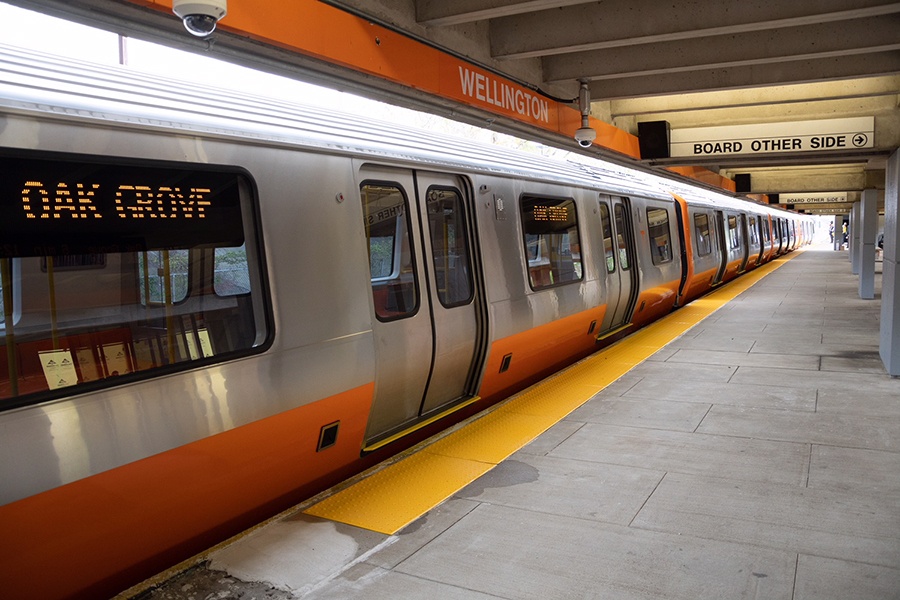
The Chinese-state owned enterprise already is years behind schedule and way over budget in completing its contract with the Massachusetts Bay Transportation Authority.
It’s been nearly a year since we last checked in on what’s happening in Massachusetts with CRRC, the Chinese-state owned enterprise (SOE) that won the contract in 2014 to manufacture hundreds of new rail cars for Boston’s subway system. We learned that federal investigators were examining whether CRRC met Buy America requirements for the rail cars it was building for the MBTA and the SEPTA system in Philadelphia — and, around the same time, there were reports that things had totally broken down between CRRC and Massachusetts officials.
Now there’s an update, at least on where things stand between the MBTA and CRRC.
A “contract reset” between the transit agency and the SOE has been reached, officially setting a new deadline of the end of 2027 for CRRC to complete the project. For those keeping track, that’s four years later than it originally promised to deliver the final car to the transit agency.
And in order to finish out the project, MBTA will need to pay up to $148 million more to account for “higher-than-expected costs linked to the pandemic and supply chain problems,” according to a report from NBC 10 Boston. Here’s the station with more details:
The tentative agreement would also waive about $90 million in penalties that the manufacturer faces for delays so far. Another $37 million in damages would remain in place, but the updated contract would set incentives that could effectively dismiss those charges as well if CRRC meets new targets.
If the contract reset wins approval, CRRC would face new deadlines to deliver all Orange Line cars by September 2025 and all Red Line cars by the end of 2027 — in both cases several years later than the original deadlines.
[Deputy General Manager Jeff] Gonneville told MBTA board members that advisors who reviewed the upheaval at Gov. Maura Healey’s instruction concluded that reshaping the CRRC contract is a better option than trying to find to an alternative manufacturer.
“A new procurement was going to take up to five years before the MBTA actually received a first vehicle, and each vehicle could be potentially $1 million more per car than a negotiation with CRRC,” he said. “The recommendation ultimately was that a reset with CRRC was in the best interest for the MBTA and our customers.”
Basically, the MBTA concluded that starting over from scratch would have ended up being more expensive than just dragging this boondoggle across the finish line. But it sure stings that the agency will likely have to spend nearly $150 million more to get this done — and that CRRC, which stands accused of greatly mismanaging this project, may get out of paying a good chunk of penalties.
This isn’t the first time costs for the project have risen. Trains magazine reported the additional $148 million “will push the total cost of the order to more than $1 billion.” One billion dollars!
Remember that the reason MBTA went with CRRC over competitors was to save money. Backed with funding and heavy subsidies from the Chinese government, CRRC offered an artificially cheap bid of $566.6 million; rival firm Hyundai Rotem had the next-lowest bid at $720.6 million.
The cost overruns and rampant delays in this project remind of what happened with the building of the San Francisco-Oakland Bay Bridge in California, during which state officials waived Buy America requirements to allow a Chinese company to make the steel for the new span, also citing lower costs. The Bay Bridge faced massive cost overruns, came in years late, and its construction was beset with safety concerns. The whole thing was such a mess the Sacramento Bee had a special page up on its website to chronicle all of the issues.
Now MBTA is facing similar woes. Along with doubling in cost and coming in years behind schedule, there continue to be safety questions raised about the quality of the rail cars being produced by CRRC. Meanwhile, a Boston Globe investigation of the CRRC factory in Springfield, Mass., described “a chaotic and often harrowing environment prone to mishaps and delays long before the pandemic began. Cars with missing parts are advanced along the assembly line without the correct paperwork and thus no way to track errors; employees bored to tears pretend to work and watch movies for months while waiting on parts to arrive as suppliers go unpaid; and workers mostly stay silent, fearing retaliation for raising concerns.”
The silver lining in all of this is the passage of the Transit Infrastructure Vehicle Security Act (TIVSA), which became law in 2020 and bans agencies from using federal tax dollars from buying rail cars or buses from Chinese SOEs like CRRC. But loopholes to that law remain, and it’s clear the Chinese government still views CRRC as critical to its goal of dominating an important global industry.
Whether it is rail cars and buses or steel and aluminum or solar panels and electric vehicles, China can and will severely undercut rivals who operate in free markets and play by the rules. But as the Bay Bridge and Boston boondoggles prove, that often proves to be a bad bargain.
